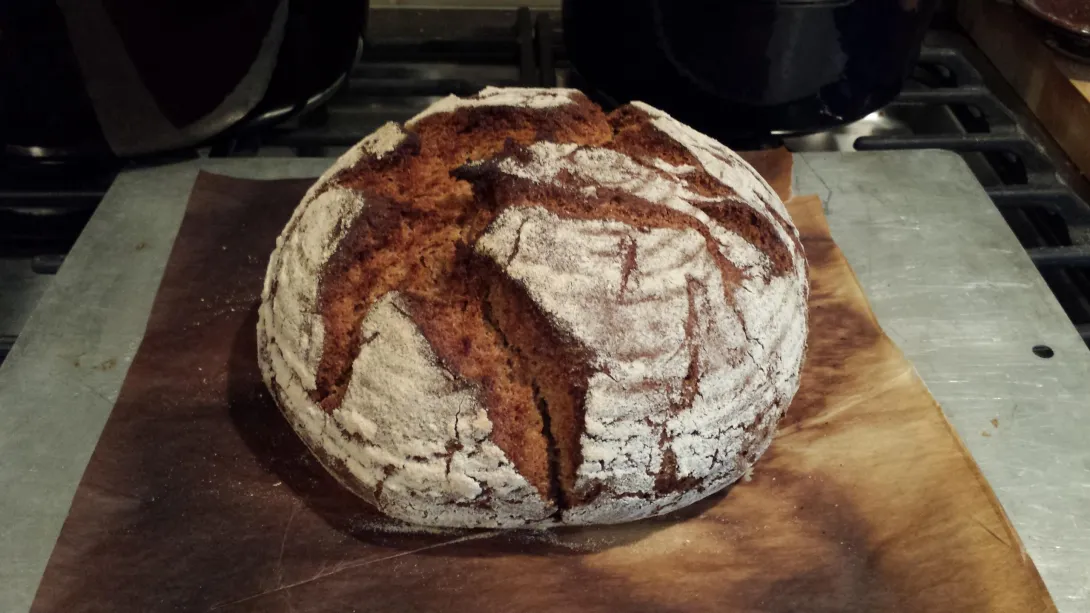
Hi everyone!
Here is my latest experiment. I have only just started making sourdough breads in the last month or so, but I decided I would dive into the deep end of the pool by trying to make this German Rye Bread:
http://brotdoc.com/2013/12/23/westfalen-kruste-westphalia-crust/
I also heavily relied on the information in the following blog post:
http://www.thefreshloaf.com//node/37266/lucy%E2%80%99s-take-adri%E2%80%99s-westphalian-rye
This bread uses a rye sourdough starter, an old bread soaker, and a rye scald. It is so different from anything I've tried before, but I chose to try it because my husband and I love the breads that we bought in Germany. I have many bread cookbooks, and most of them have one or two rye bread recipes, but nothing lke this bread. From the very start, I felt out of my depth. I didn't know what a scald was, or what it should look like. I wasn't sure how I was going to keep it at the required temperature for two hours. My starter was good, though, so I wasn't worried about that.
When I mixed the dough, however, it didn't feel like any bread dough I had ever mixed before. All of the liquid was in the soaker, scald and levain. The high percentage of rye flour also kind of threw me. The texture was not anything like wheat dough. I know that it doesn't develop gluten the way wheat does, but I didn't know if I had mixed it for not long enough, just right, or too much. The recipe does have a small amount of commercial yeast, and it said the bulk fermentation was supposed to be only 45 minutes. Then shape the boule and let it rise again in the brotform for 60 minutes. At every step of the way, this bread seemed foreign to me. I didn't know what the dough should feel like, couldn't judge if it had risen enough, etc. I have been baking wheat bread for so long that i know how to look at and feel the dough to know if it is ready for the next step or not. No so with this bread.
The thing that scares me about this bread is how heavy it is. It looks good on the outside, but it feels like it is going to be a doorstop! My loaf looks considerably smaller to me than the one in the pictures, but it is really heavy. I think it is going to be too dense. Hopefully, it will still be edible!
I would appreciate any suggestions about how to judge the "feel" of the dough, and how to judge whether the fermentation is correct.
Thanks!
- Kasiaw's Blog
- Log in or register to post comments
you got on the outside, the inside should be fine especially with the commercial yeast kicker that I didn't use. I think that you will like the crumb and the taste is amazing - it will remind you of the breads from Germany for sure. This bread is in the running for Lucy's best bread in 2014 - it is that good. Well done and happy baking.
The outside looks wonderful, but the inside is heavy and dense. The flavor is very good, but I think that either I didn't mix it long enough in the KA, or I should have let it proof longer in both bulk and shaped fermentation. I was kind of afraid of overmixing, since I read a comment that said that would make it gummy. This bread is not gummy, just not aerated inside. I didn't mix it as long in the mixer as the recipe called for, so next time I will try that. I also need to be willing to let it rest longer, if it is rising slower than called for in the recipe. Patience has always been a struggle for me!
Thanks for the help!
They say patience comes to those who wait a long, long time. I don't use commercial yeast in SD breads so I don't know how long it should take to ferment and proof but I did add 1/2 hour to the ferment and 2 hours to the proof because the commercial yeast wasn't used. The outside looks like the inside should be fine.